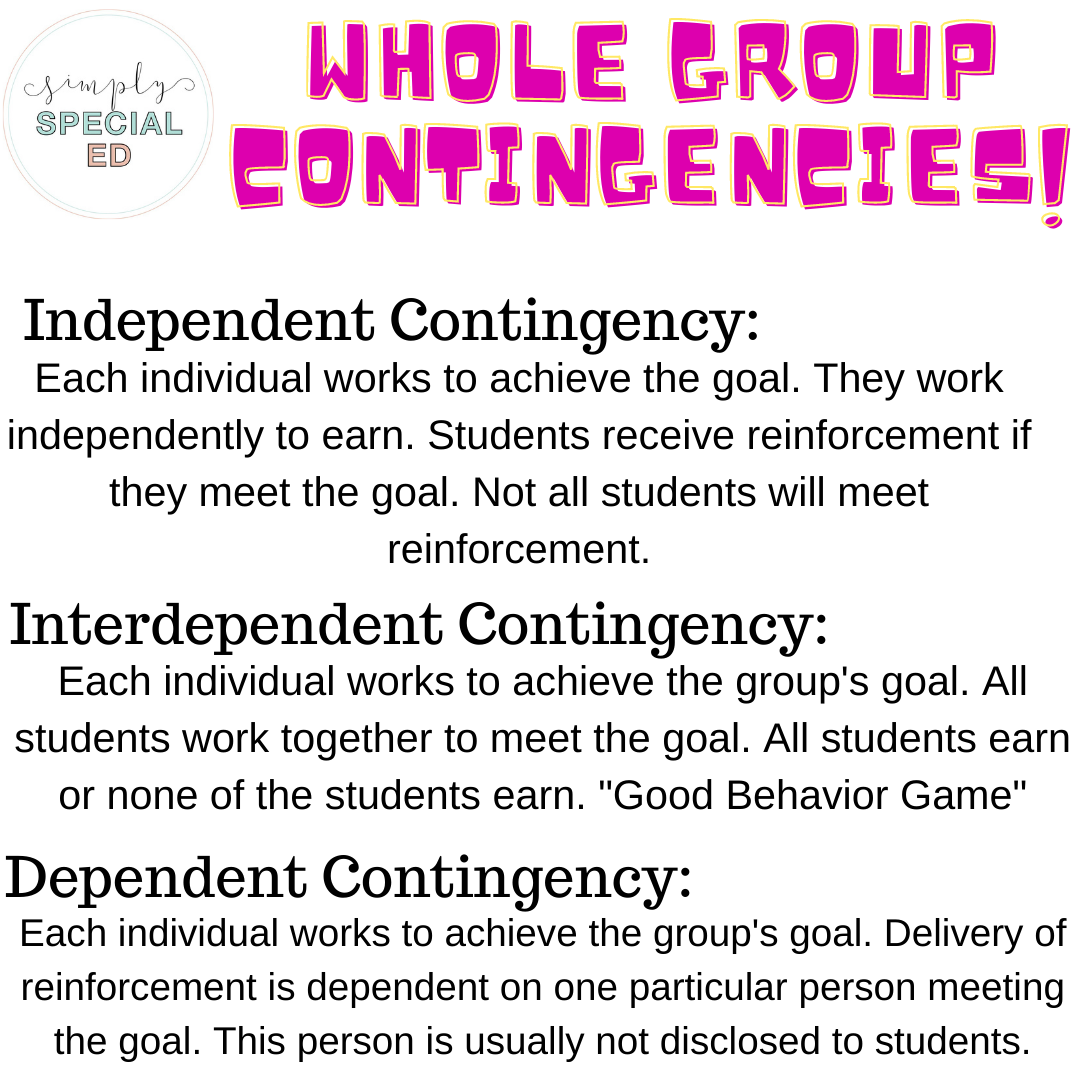Pros and Cons: Whole Group Contingencies

In most public school settings, there are school wide (or class wide) positive behavior intervention and support (PBIS) programs. PBIS is the non-behavior analytic term for whole group contingencies. As you can imagine, these work in schools with varied success for a variety of reasons. Before I discuss the pros and cons of whole group contingencies, I want to explain the different types. This will hopefully assist you in understanding why your PBIS system may (or may not) work.
Three Types of Whole Group Contingencies

Independent Contingency
In an independent group contingency, each student will work to achieve a goal. Each student’s access to reinforcement is based simply on their ability to meet the goal. This is a “traditional” PBIS system. For example, a school gives “behavior bucks” for walking quietly in the hallway and cleaning up after lunch. Each student is accountable to earning their own “behavior bucks” that they can then use to shop at the school store. Some kids will earn behavior bucks daily, while others may not ever earn. The kids who do not earn do not effect the students who do. Other examples: sticker chart, ClassDojo, point systems

Interdependent Group Contingency
In an interdependent group contingency, all students are working to meet one goal. Each student’s behavior is still individually reinforced with generalized conditioned reinforcers (points or marbles, etc) but all students have access to the terminal reinforcer, regardless of individual earning. This is commonly called “The Good Behavior Game”. Commonly, you see this as marble jars or earning a class pizza party.
Dependent Group Contingency
A depended group contingency is when the reinforcement of all is dependent on the behavior of one specific child. Most often, this student is not disclosed but occasionally they are known. In classrooms, this looks like “secret student”. To create a secret student system, write each of your students names on a popsicle stick, pull one random stick and tell the students that you are watching out for good behavior. If that student meets expectations, the whole group earns reinforcement. If that student does not meet expectations, the whole group does not earn.

Pros of Using Whole Group Contingencies
Let me be transparent. I don’t frequently use whole group contingencies. There certainly is a time and place for them, but my classroom isn’t one. That being said, there are plenty of positive reasons to use a group contingency.
Pro #1: Collaborative
When using a whole group contingency, it is super important to create the “rules” with your students. Ask them what they think they need to do in order to “earn”. Very often, this looks like creating classroom rules, a class wide behavior contract and/or discussing expectations during morning meeting. I find that Responsive Classroom has a lot of great resources about to how to introduce these contingencies in your classroom.
Pro #2: Students earn meaningful reinforcers.
Regardless of the type of whole group contingency you use (or any reinforcement contingency in general), it is critical that there is motivating operations to want to earn the reinforcer. For example, if your students are earning a pizza party, play the Good Behavior Game right before lunch. Since they are working toward a edible based reinforcer, give them opportunities to earn while they are hungry. They will be more motivated to earn/meet expectations if they are not satiated.
I used pizza as an example, but anything can be a meaningful reinforcer for your class. Ask them what they want to earn. In the past, I have taught bar graphs by asking students what they want to work for and graphing it. It is a great visual to see “majority” and/or aggregate a list of possibly reinforcing items/activities.
Pro #3: Can be school wide
When utilizing a school wide PBIS system, chances are your students will be familiar with it (unless you teach kindergarten). This assists in buy in and understanding of what expectations should/can be.

Cons of Whole Group Contingencies
When using whole group contingencies, there are many things you need to look out for. These are some of the most pressing warnings of using whole group contingencies ethically.
Con #1: Students feel left out/get bullied
Especially when using interdependent or dependent group contingencies, stigmatization can happen very quickly. When using these contingencies in general education/inclusion settings, our special education students tend to be the students blamed when the class does not earn (regardless if they were the target student or not). These contingencies can reinforce student policing each other, tattling, and/or bullying of students who have challenging behaviors.
Con #2: Not all students will earn- which can trigger more intense behaviors
When you use some kind of independent group contingency in your classroom, your students who easily follow directions and expectations will always be the first to earn reinforcers. But what about your students who have difficulty following those rules? Will they earn? Probably not. And what happens when their peers who did meet expectations get to pick a prize from the treasure chest? Probably an explosion of maladaptive behavior. This not only perpetuates the understanding for the student (and their peers) that their behavior (often seen as their person) is bad.
Con #3: Some students simply will not be motivated to earn
Regardless of the contingency, it is critical that there is motivation to earn the reinforcer. Like stated above, there must be a motivating operation for EVERY student in order for their to be full buy in. If students are not motivated by the reinforcer, they often do not care to meet behavioral expectations. Any time you are working with external reinforcement and external motivation, you are met with the predicament of how the students are understanding what is happening. How can you build intrinsic motivation to do the right thing?
What are your thoughts?
Ultimately, I feel that the ethical responsibility of educators is to teach students how to be accountable for themselves, not just to be held accountable by teachers. If you choose to use a whole group contingency, be sure to regularly review the expectations and possible outcomes. If you want to read more about types of behavior supports, read my post here.


The post Pros and Cons: Whole Group Contingencies appeared first on Simply Special Ed.
